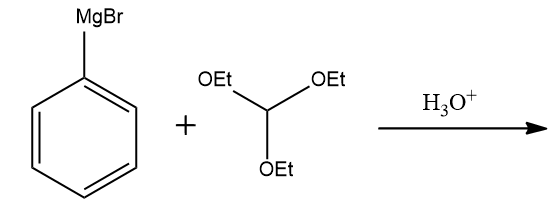
Complete the following reaction.


Answer
513k+ views
Hint :This is a Grignard reaction. The Grignard Reaction is the addition of an organomagnesium halide (Grignard reagent) to a ketone or aldehyde, to form a tertiary or secondary alcohol, respectively. The reaction with formaldehyde leads to a primary alcohol.
Complete Step By Step Answer:
The Grignard reaction is an organometallic synthetic reaction in which alkyl, allyl, vinyl, or aryl-magnesium halides (Grignard reagent) is added to a carbonyl gathering in an aldehyde or ketone. This reaction is significant for the development of carbon–carbon bonds. The reaction of a natural halide with magnesium isn't a Grignard reaction, however gives a Grignard reagent.

Additional Information:
Grignard reagents are made through the expansion of magnesium metal to alkyl or alkenyl halides. The halide can be $ Cl, $ $ Br $ , $ I, $ (not $ F $ ) . It's marginally simpler to make Grignards from the iodides and bromides, nonetheless. Note what's going on here – the magnesium is "embeddings" itself between the carbon and the halide. This halide the " $ X $ " alluded to when we allude to Grignard reagents as " $ RMgX $ ".They're very acceptable nucleophiles, responding with electrophiles like carbonyl mixtures (aldehydes, ketones, esters, carbon dioxide, and so on) and epoxides. They're additionally solid bases and will respond with acidic hydrogens (like alcohols, water, and carboxylic acids).
Note :
Grignard reagents are utilized artificially to frame new carbon–carbon bonds. A Grignard reagent has a polar carbon–magnesium bond in which the carbon molecule has an incomplete negative charge and the metal a fractional positive charge.
Complete Step By Step Answer:
The Grignard reaction is an organometallic synthetic reaction in which alkyl, allyl, vinyl, or aryl-magnesium halides (Grignard reagent) is added to a carbonyl gathering in an aldehyde or ketone. This reaction is significant for the development of carbon–carbon bonds. The reaction of a natural halide with magnesium isn't a Grignard reaction, however gives a Grignard reagent.

Additional Information:
Grignard reagents are made through the expansion of magnesium metal to alkyl or alkenyl halides. The halide can be $ Cl, $ $ Br $ , $ I, $ (not $ F $ ) . It's marginally simpler to make Grignards from the iodides and bromides, nonetheless. Note what's going on here – the magnesium is "embeddings" itself between the carbon and the halide. This halide the " $ X $ " alluded to when we allude to Grignard reagents as " $ RMgX $ ".They're very acceptable nucleophiles, responding with electrophiles like carbonyl mixtures (aldehydes, ketones, esters, carbon dioxide, and so on) and epoxides. They're additionally solid bases and will respond with acidic hydrogens (like alcohols, water, and carboxylic acids).
Note :
Grignard reagents are utilized artificially to frame new carbon–carbon bonds. A Grignard reagent has a polar carbon–magnesium bond in which the carbon molecule has an incomplete negative charge and the metal a fractional positive charge.
Recently Updated Pages
A man running at a speed 5 ms is viewed in the side class 12 physics CBSE

State and explain Hardy Weinbergs Principle class 12 biology CBSE

Which of the following statements is wrong a Amnion class 12 biology CBSE

Two Planoconcave lenses 1 and 2 of glass of refractive class 12 physics CBSE

The compound 2 methyl 2 butene on reaction with NaIO4 class 12 chemistry CBSE

Bacterial cell wall is made up of A Cellulose B Hemicellulose class 12 biology CBSE

Trending doubts
What are the major means of transport Explain each class 12 social science CBSE

Which are the Top 10 Largest Countries of the World?

Draw a labelled sketch of the human eye class 12 physics CBSE

Explain sex determination in humans with line diag class 12 biology CBSE

The pH of the pancreatic juice is A 64 B 86 C 120 D class 12 biology CBSE

Give 10 examples of unisexual and bisexual flowers




